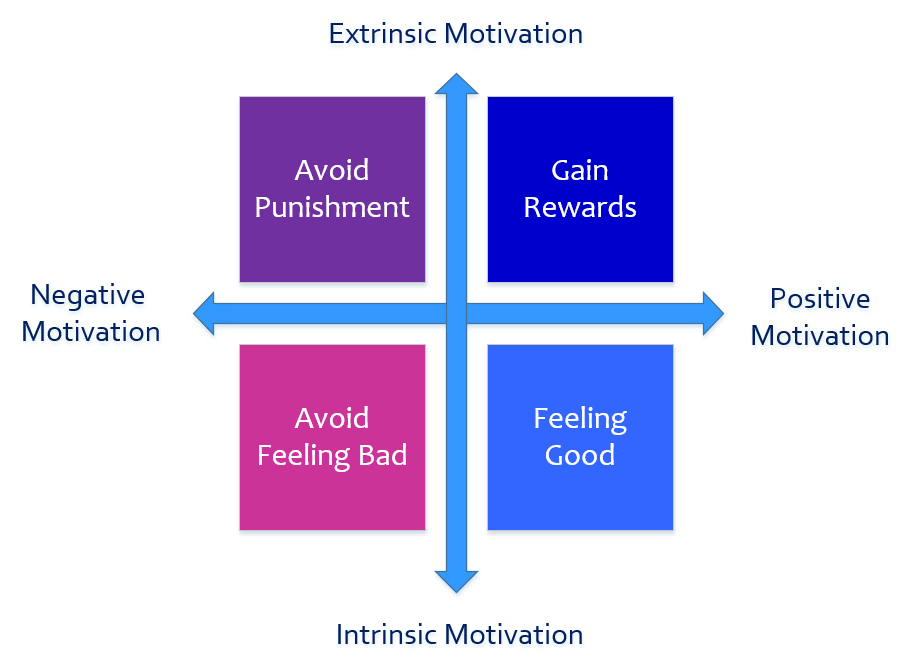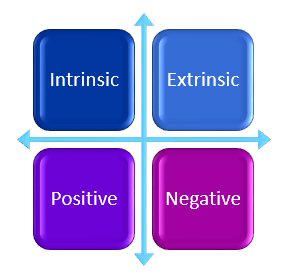What is Motivation?
Motivation is the desire or willingness to engage or entertain a specific thought, action, or habit. It is the reason behind why a person is compelled to act a certain way.
Motivation may be classified as the following:
- Extrinsic or Intrinsic
- Positive or Negative
Four Dimensions of Motivation
Extrinsic Motivation is a desire to perform an activity in order to gain a reward or avoid a punishment.
Intrinsic Motivation is a desire to perform a specific activity because taking part in the activity brings personal joy and satisfaction.
Positive Motivation is an influence on a person’s behavior through recognition and appreciation of their efforts to inspire them to achieve their goals and reach their full potential.
Negative Motivation is an influence that drives a person to complete a task to avoid undesirable outcomes such as pain or failure.
Four Quadrants
These four classifications of motivation create four quadrants. These quadrants are formed by the converse types of motivation and how they intersect. The two converse types of motivation are grouped as either Extrinsic vs. Intrinsic or Positive vs. Negative.
Extrinsic vs. Intrinsic – Extrinsic motivations originate outside the individual, while intrinsic motivations originate within the person.
Positive vs. Negative – Positive motivation promotes emotional pleasure, while negative motivation serves to avoid undesirable experiences.
When these groups intersect, they form the four quadrants. For example, motivation can be both extrinsic and positive or extrinsic and negative. The following image shows the four quadrants.
Four Dimensions of Motivation
Positive Motivation – a person is gaining rewards and feeling good.
Negative Motivation – a person is avoiding negative consequences or feeling bad.
Extrinsic motivation – a person either gets rewards from an outside source or avoids punishment for undesirable results.
Intrinsic motivation – a person is either avoiding bad feeling or trying to create good feelings.
Converse Types of Motivation
Intrinsic or Extrinsic
Motivation can be either intrinsic or extrinsic. Intrinsic motivation comes from within an individual, while extrinsic motivation arises from external sources. Intrinsic motivation centers on doing an activity because it is enjoyable and personally rewarding. Extrinsic motivation involves doing something to earn a reward or avoid punishment. However, motivation is more complex than simply categorizing it as intrinsic vs extrinsic.
Positive or Negative
Motivation can be either positive or negative. Positive motivation occurs when a person knows that they will be rewarded for accomplishing a certain task or changing a particular behavior. On the contrary, negative motivation is the act of forcing a specific behavior by means of fear, threat, or punishment. Basically, positive motivation is when a person behaves a certain way to get rewarded, and negative motivation is when a person behaves a certain way to avoid something bad.
Intrinsic Motivation – Positive and Negative
Intrinsic motivation means that the individual’s motivation is coming from within that person. The individual has the desire to perform a specific task or activity because it is personally gratifying. For example, a person may be motivated to volunteer for an organization because it can positively impact the lives of others, and that makes them feel good about themselves.
However, while that example demonstrates positive reasoning, intrinsic motivation can also have negative drivers. For example, a person can be motivated to volunteer because they fear not getting into a good college if they do not have a good resume. Even though the outcome of the action is the same for both examples, the motivation behind it Is different. In the second example, the motivation behind the decision was focused on stopping a negative outcome rather than creating a positive outcome.
Extrinsic Motivation – Positive and Negative
?Extrinsic motivation means that the individual’s motivation is coming from outside sources. The individual has the desire to perform a specific task or activity because they expect to receive a benefit or reward for their actions. For example, a person may be motivated to work extra hours because they will receive a monetary bonus. In this example, they are receiving a positive reward to the work.
However, extrinsic motivation can sometimes be negative. For example, a person may be motivated to work extra hours due to fear of being fired. In this example, the person is motivated by avoiding negative consequences, and not by a reward.
These diverse examples shows that extrinsic motivation can have both positive and negative motivators.


